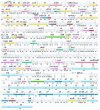Complete genome sequence of the broad-host-range vibriophage KVP40: comparative genomics of a T4-related bacteriophage
- PMID: 12923095
- PMCID: PMC180978
- DOI: 10.1128/JB.185.17.5220-5233.2003
Complete genome sequence of the broad-host-range vibriophage KVP40: comparative genomics of a T4-related bacteriophage
Abstract
The complete genome sequence of the T4-like, broad-host-range vibriophage KVP40 has been determined. The genome sequence is 244,835 bp, with an overall G+C content of 42.6%. It encodes 386 putative protein-encoding open reading frames (CDSs), 30 tRNAs, 33 T4-like late promoters, and 57 potential rho-independent terminators. Overall, 92.1% of the KVP40 genome is coding, with an average CDS size of 587 bp. While 65% of the CDSs were unique to KVP40 and had no known function, the genome sequence and organization show specific regions of extensive conservation with phage T4. At least 99 KVP40 CDSs have homologs in the T4 genome (Blast alignments of 45 to 68% amino acid similarity). The shared CDSs represent 36% of all T4 CDSs but only 26% of those from KVP40. There is extensive representation of the DNA replication, recombination, and repair enzymes as well as the viral capsid and tail structural genes. KVP40 lacks several T4 enzymes involved in host DNA degradation, appears not to synthesize the modified cytosine (hydroxymethyl glucose) present in T-even phages, and lacks group I introns. KVP40 likely utilizes the T4-type sigma-55 late transcription apparatus, but features of early- or middle-mode transcription were not identified. There are 26 CDSs that have no viral homolog, and many did not necessarily originate from Vibrio spp., suggesting an even broader host range for KVP40. From these latter CDSs, an NAD salvage pathway was inferred that appears to be unique among bacteriophages. Features of the KVP40 genome that distinguish it from T4 are presented, as well as those, such as the replication and virion gene clusters, that are substantially conserved.
Figures




References
-
- Ackermann, H.-W., and H. M. Krisch. 1997. A catalogue of T4-type bacteriophages. Arch. Virol. 142:2329-2345. - PubMed
-
- Alberts, B., and R. Miake-Lye. 1992. Unscrambling the puzzle of biological machines: the importance of the details. Cell 68:415-420. - PubMed
-
- Ang, D., A. Richardson, M. P. Mayer, F. Keppel, H. Krisch, and C. Georgopoulos. 2001. Pseudo-T-even bacteriophage RB49 encodes CocO, a cochaperonin for GroEL, which can substitute for Escherichia coli's GroES and bacteriophage T4's Gp31. J. Biol. Chem. 276:8720-8726. - PubMed
-
- Bhagwat, M., and N. G. Nossal. 2001. Bacteriophage T4 RNase H removes both RNA primers and adjacent DNA from the 5′ end of lagging-strand fragments. J. Biol. Chem. 276:28516-28524. - PubMed
Publication types
MeSH terms
Substances
Associated data
- Actions
LinkOut - more resources
Full Text Sources
Other Literature Sources
Research Materials
Miscellaneous

